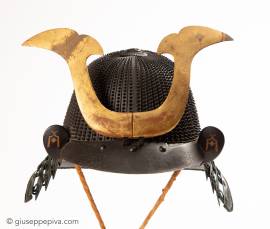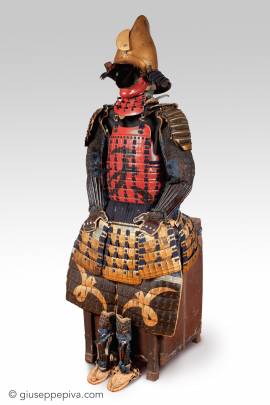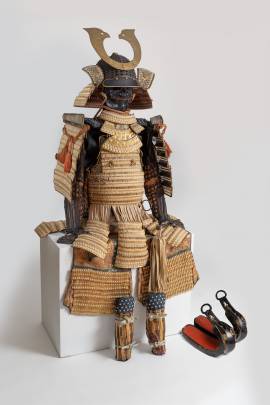Koboshi kabutoSamurai helmet with standing rivetsEarly Edo Period, 17th Century A 62-plate koboshi-bachi [helmet bowl with small standing rivets] with 30 pointed rivets on each plate decreasing in size towards the top, with the exception of the larger front plate, with two lines of rivets and the small one on the back which is left blank, for a total of 1,860 rivets.The helmet is fitted with a five-plates neck protection (shikoro) of hineno style, typical of the period.The double tsunomoto riveted on the visor holds a wooden front decoration (maedate) with the classical...
WORKS FOR SALE
Momoyama period16th centuryKabuto of eboshi type in gilt lacquer with hineno shikoro with five narrow plates. Maedate in the shape of a crescent moon.Menpō of hanbō type in red lacquer with a three-plate yodarekake.Rare maru-do with iyozane-type plates, consisting of a single element, decorated with a large kanji "ten" in black lacquer on red at the front. The curvature of the armpit is typical of the Momyama period, as is the shape of the slightly sunken back.Golden ko-sode with a cut corner at the front to facilitate fighting.Haidate with mirrored kamon in gold lacquer on a...
Samurai armor bearing the kamon of the Toyama familyEdo Period, 18th centuryHand-written origami by Prof. Yamagami Hachirō (1902-1980), dated 31 March 1964.Due to its high production cost, golden armor was infrequent during the Edo period. The hon-kozane (true scale) construction for the cuirass, the engraved gilt brass borders, and the haidate (thigh guard) decorated with a floral scroll motif painted with black lacquer over gold all indicate that this suit belonged to a samurai of a wealthy clan. The armor also features a nodowa, an additional protection for neck and throat...
Copyright © 2016 - giuseppe piva - VAT: 05104180962










